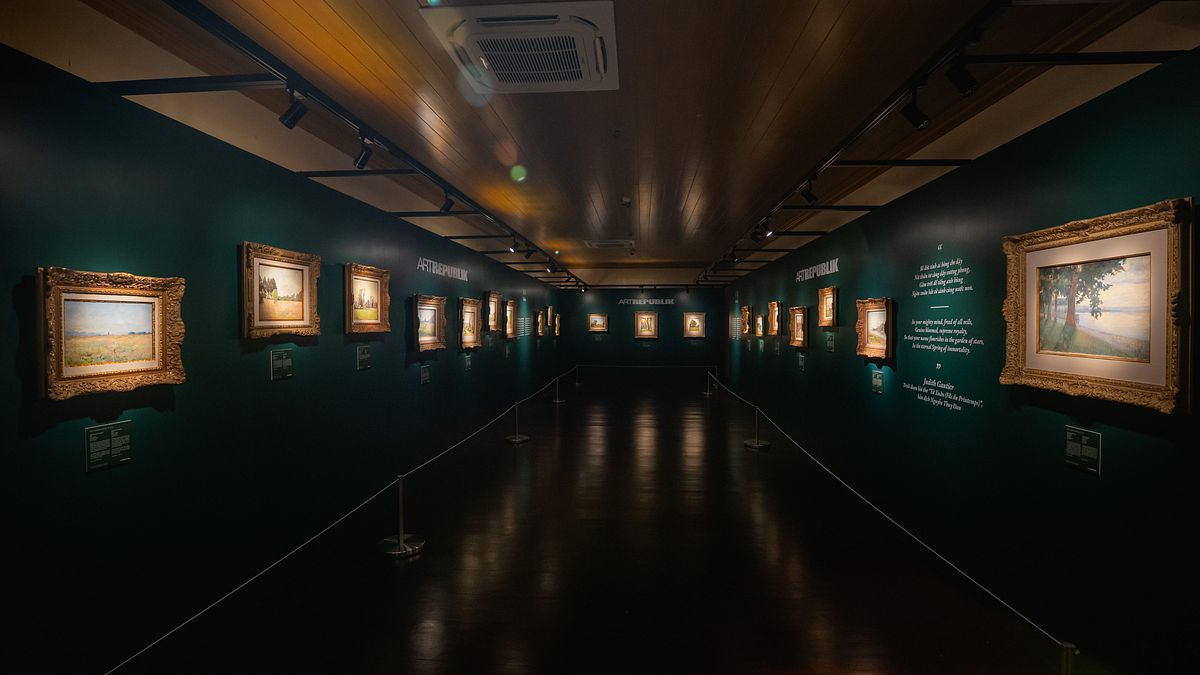An exhibition offering a rare glimpse into the artistic life of Hàm Nghi, Vietnam's exiled emperor who dedicated his life to art, with brushstrokes and landscapes reflecting his deep longing towards a distant homeland that he could never return to.

Installation view of “Trời, Non, Nước | Allusive Panorama.” Photo courtesy of Luxuo.
Since March 26, 2025, Kiến Trung Palace of the Imperial City of Huế has welcomed thousands of visitors per day for the special exhibition “Trời, Non, Nước | Allusive Panorama,” honoring the legacy of Emperor Hàm Nghi through more than 20 paintings from 10 different private collections. Art Republik Vietnam, in collaboration with the Hue Monuments Conservation Centre and the French Institute in Vietnam, organized the exhibition as a symbolic homecoming for the works of an exiled emperor, now returning to the ancient royal palace. Curated by art researcher Ace Lê and Dr. Amandine Dabat, the Emperor’s 5th descendant, the exhibition remains open to the public for just two weeks, offering a rare and fleeting glimpse into Hàm Nghi’s artistic legacy and representing a significant milestone in the work of restoring Vietnam’s cultural heritage.

Paysage aux Cyprès (Landscape with cypress trees) (Menthon-Saint-Bernard), 1906. 27 x 40,5 cm, oil on canvas. Photo courtesy of Kâ- Mondo.
Through the eyes of the Vietnamese people, Hàm Nghi is widely recognized as a patriotic ruler who played a key role in the Cần Vương movement (1885–1896), resisting French colonial rule to reclaim national sovereignty. Ascending the throne at the age of 13 under the regency of Nguyễn Văn Tường and Tôn Thất Thuyết, he expressed a deep sense of patriotism from an early age. Despite his royal lineage, he spent his childhood with his mother outside of the palace, an experience that kept him from being blinded by power and wealth. His reign, albeit short-lived, unfolded during a period of dual crisis: internal conflicts within the royal court and the external political turmoil caused by the French colonial invasion.

Portrait of Emperor Hàm Nghi, 1896.
Photo courtesy of Archives nationales d'outre-mer, Fonds Capek.
The exhibition unfolds across multiple areas within Kiến Trung Palace, beginning on the upper floor with a calligraphy room. This calligraphy collection traces the timeline leading up to Hàm Nghi’s capture and exile by the French, where he would spend the remaining 55 years of his life far from the motherland. Positioned on the upper floor above the reception area — where artifacts used by the imperial family are exhibited — this space features a collection of calligraphy works with poems written in support of the Cần Vương movement.

Installation view of “Trời, Non, Nước | Allusive Panorama.”
Photo courtesy of Luxuo, Bảo Nguyễn/Annam Production.

Installation view of “Trời, Non, Nước | Allusive Panorama.”
Photo courtesy of Luxuo, Bảo Nguyễn/Annam Production.
Little is known about the Emperor’s life after being exiled to French Algeria in 1888 at the age of 18, where he remained a political prisoner under strict surveillance. To cope with loneliness, isolation and the ever-present control of the colonial authority, he devoted himself to art, training under Marius Reynaud (1860–1935) and later absorbing influences from Impressionism and Post-Impressionism during his time in Paris. He also studied sculpture under the renowned Auguste Rodin (1840–1917), though this exhibition focuses solely on his paintings. Hàm Nghi signed his paintings with the name Tử Xuân 子春 (“the son of spring”), a childhood name given by his family members and close relatives.
Upon arrival at the main exhibition space, visitors are immediately drawn to the luminous and dreamy color palette of Hàm Nghi’s oil paintings, created between the 1910s and 1920s in this exhibition. Dominated by landscapes and nature, his works inherit the influence of Impressionism, directly aligning with the exhibition title “Trời, Non, Nước” (Sky, Mountains, Water). According to the curatorial text, Hàm Nghi was the first Vietnamese artist to receive formal academic training in western academic techniques, preceding the establishment of the Indochina School of Fine Arts in 1924. While his works do not overly depict traditional Vietnamese imagery, the subtle details within his landscapes evoke the familiarity and nostalgia of Vietnamese rural landscape, revealing the insight into the construction of his personal and artistic identity. Notably, the human presence remains almost non-existent in most of his paintings, further emphasizing a sense of solitude.

A part of the exhibition “Trời, Non, Nước | Allusive Panorama.”
Photo courtesy of Bảo Nguyễn/Annam Production.
From a technical perspective, the strength of Hàm Nghi’s landscape paintings lies in his mastery of light and atmospheric effect. His meticulous studies of the sky, sunrise and sunset, combined with carefully composed horizontal lines, create a sense of depth. The harmony between light and shadow is particularly evident in the reflections of natural elements upon the water; the reflections of natural elements capture both its transparency and the subtle contrast between luminosity and darkness. Hàm Nghi embraced the Impressionist movement’s significance of painting en plein air, and prioritized the immediate emotions and fleeting moments as they unfolded before him.

Champs de blé (Wheat field), 1913. 31 x 39 cm. Oil on canvas. Photo courtesy of Lynda Trouvé.

Paysage Algérien (Algerian Landscape), 1902. 24.1 x 35.4 cm. Oil on canvas. Photo courtesy of Kâ-Mondo.
Beyond the image of an emperor, Hàm Nghi’s works reveal a deeply personal side: one of a human being shaped by emotions released through the vastness of nature, one who was caught in the tides of political turmoil that dictated his fate. The subject matters in his paintings reflect his inner world, infused with subtle metaphors of longing and displacement: an ancient solitary tree standing alone in silence, an empty path without the human presence, reflecting his path as a ruler, the life where he was granted the title of a ruler, yet never had any power to make his own decisions. The elements in his works, woven together with the curatorial narrative, embody the key elements: sky — a symbol of far-reaching vision; mountain — standing tall and steadily, even in solitude; and water — fluid and ever-changing, reflecting all matters, including life itself. To be an emperor is to possess a great vision, overseeing the vast landscape of one’s homeland.
Meanwhile, back in his homeland, The Cần Vương movement, albeit weakened over the years, persisted until 1896, nearly another decade after Hàm Nghi’s exile. Despite its eventual failure due to lack of strategy, centralized leadership and military inferiority, the movement remains a testament to the resilience and the patriotic spirit of the people against colonial rule, even after their leaders sacrificed and faded away from power.

Installation view of ‘Trời, Non, Nước | Allusive Panorama’.
Photo courtesy of Bảo Nguyễn/Annam Production.
The significance of this exhibition, made possible by years of research and the dedication of many individuals and organizations, extends beyond the story of Hàm Nghi as an emperor in exile who never lost his connection to Vietnam, despite being displaced and stripped of political influence. His legacy lives on through his art, a reflection of perseverance, identity and the spirit of a nation.
By force, an emperor may be taken away from his homeland. However, his homeland can never be taken away from his heart and soul.
“Trời, Non, Nước | Allusive Panorama” is now on view at the Kiến Trung Palace of the Imperial City of Huế until April 6, 2025. More information on the exhibition can be found here on the website and Facebook page.
















